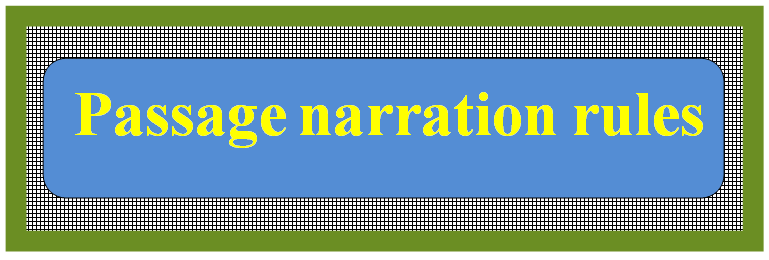
Passage narration rules
Passage narration includes different kinds of sentences. If the reported speech contains more than one type of sentence such as an interrogative, an assertive, and an exclamatory sentence, then indirect speech has to be made by changing the sentences according to the narration change rules for changing the sentence.
Before changing the passage narrations read the passage well and identify the speaker and the listener in the passage.
No new rules are required to change passage narration.
Example:
Direct: Rita said to Mita, “You are a good girl. Could you help me with this book please?”
Indirect: Rita told Mita that she was a good girl and requested to help her with that book.
Direct: The old man said to me, “ Your father is my old friend. May God bless you.”
Indirect: The old man told me that my father was his old friend and prayed that God might bless me.
Rule No: 01
In direct speech, even if the reporting verb is in the middle or at the end of the speech, it should be brought at the beginning of the sentence while making an indirect speech.
Example:
Direct: “What can I teach you?” asked Nasiruddin.
Indirect: Nasiruddin asked the students what he could teach them.
Direct: “Don’t say a word to anyone?” said the cave-man.
Indirect: The cave-man asked not to say a word to anyone.
Direct: “Have you killed the rats?” said the Mayor.
Indirect: The Mayor asked the people if they had killed the rats.
Direct: “ You look a little bit like my mother,” Jerry said to the authoress, “Especially in the dark by the fire.”
Indirect: Jerry told the authoress that she looked a little bit like his mother especially in the dark by the fire.
Rule No: 02
If there is more than one quote (Narration) of a speaker, in the case of 2nd or subsequent quote (Narration), in order to do the indirect narration, one has to follow the following rules to maintain the continuity of the sentence.
1) Added / further added / also said / again said etc. are to be used in Assertive sentence.
2) In case of interrogative sentence also asked / again asked / further asked etc. is to be used.
Example:
Direct: The master said to the servant, “ Stop your work soon and go home now. You may start the work tomorrow morning.”
Indirect: The master told the servant to stop his work soon and go home then. He added that the servant might start the work the next morning.
Direct: “I was afraid of seeing a bear coming to us in the jungle, said one of the two friends, “and I did not know how to climb a tree. So, I have decided to lie asleep on the ground like a dead man.
Indirect: One of the two friends said that he had been afraid of seeing a bear coming to them in the jungle and he had not known how to climb a tree. He added that that was why he had decided to lie asleep on the ground like a dead man.
Rule No: 03
In the case of a conversation sentence usually, one person asks the question and the other answers it. The rules of the answer sentence (Assertive etc.) should be applied there. NP + reply / replied that must be added.
Example:
Direct: Merry said, “What are you doing, Shovan?”
Shovan said, “I am writing a report.”
Indirect: Merry asked Shovan what he was doing. Shovan replied that he was writing a report.
Rule No: 04
If there is only “Yes” in the reported speech, then ‘replied in the affirmative‘ should be used instead of “Yes” while making an indirect sentence.
Example:
Direct: “Mother,” said the boy, “ Have you cooked food?” “Yes, I have. You can eat now.” his mother said.
Indirect: The boy asked his mother if she had cooked food. His mother replied in the affirmative that she had cooked. She (mother) added that he could eat then.
Rule No: 05
If there is any statement after “Yes” in the reported speech, then instead of “Yes” in the indirect speech, there will be ‘replied in the affirmative and said that.
Example:
Direct: The Mayor said, “Have you killed the rats?” “Yes, I have. ’’ said the Piper. “Please give me the promised money”
Indirect: The Mayor asked the Piper if he had killed the rats. The Piper replied in the affirmative and requested him (Mayor) to give him (Piper) the promised money.
Rule No: 06
If there is only “No” in the reported speech then ‘replied in the negative’ should be used instead of “No” while making indirect narration. Or the required Auxiliary verb + not is used after the Subject.
Example:
Direct: Rita said to Mita, “ Are you writing the report now?” Mita said, “No.”
Indirect: Rita asked Mita if she was writing the report then. Mita replied in the affirmative.
Rule No: 07
If there is any statement after “No” in the reported speech then ‘replied in the negative and said that’ will sit instead of “No” in the indirect speech.
Example:
Direct: John said to Shilla, “Are you visiting the beach tomorrow?” “ No, I have changed my decision,” said Shilla.
Indirect: John asked Shilla if she was visiting the beach the next day. Shilla replied in the negative and said that she had changed her decision.
Passage narration rules
Related Term:
